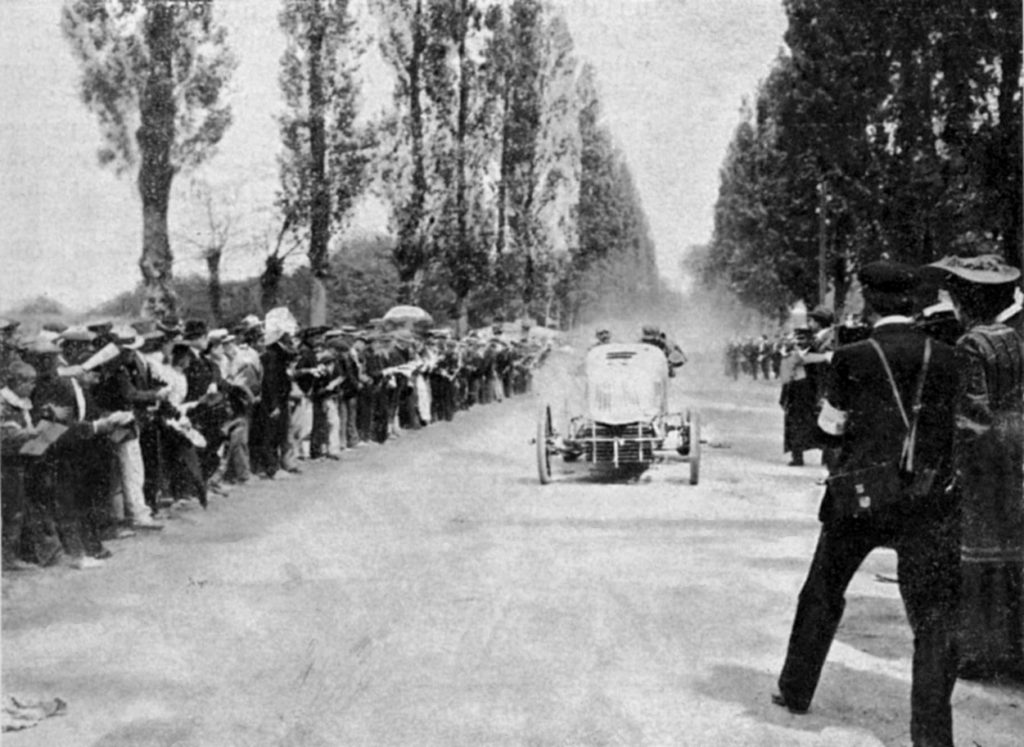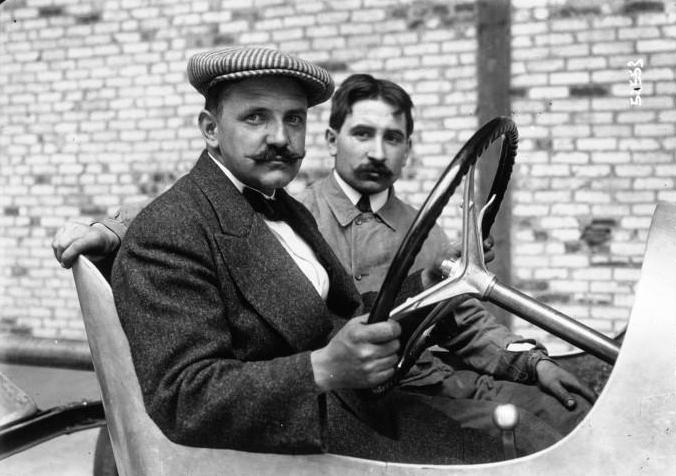In the night of August 3, 1914, German troops invaded Belgium, bringing an end to the first era of motor racing that had started in 1894.
An epoch of ‘horseless carriages’ powered by petrol, kerosene, steam or electricity. Experimental cars balancing on thin and flimsy tyres, lacking suspension, stopping power or protection against the elements. Drivers raced smudged and bruised, covering monstrous distances on improvised and unpaved circuits. Primitive yet brutal technology, combined with lack of organisation, posed huge risks to competitors and spectators alike.
A time now largely forgotten from public memory, one of pioneers such as Fernand Gabriel, a short Parisian who, never with the best of machinery, drew from unfathomed depths to some astonishing drives.
Fernand Gabriel was born in Paris in 1878. Little is known about his youth, what he studied, or how he came to racing, but his first race on record was Paris-Bordeaux on May 24th 1899. Gabriel drove in a Decauville, a little and lightweight car — also called a Voiturettes, or cyclecar — but he would retire early on.
One month later though Gabriel started the first Tour du France Automobile, which ran seven stages in nine days. Out of 49 starters, 21 finished. Frenchman René de Knyff won the general class for Panhard, as Fernand Gabriel finished first in the Voiturettes class, thus setting a name for himself.
Gabriel isn’t listed as competitor in any race in 1900, but in 1901 — the year he married a woman named Berthe Cerisay — he switched to driving for Darracq, winning the Voiturettes class in a race in the Belgian city of Oostende.
In early 1902 he competed in the one of the first mountain climbs, a race that started in Nice and went 16 kilometres uphill to the village La Turbie in the mountains. Once more Gabriel won the lightweight class, but this time only 13 seconds behind the overall winner. A few months later, he switched to racing in the heavier class with manufacturer Mors. He retired in Paris-Vienna, and was denied a clear victory at the Circuit des Ardennes due to a breakdown on the final lap, taking second place at the finish.
But things went his way in August that year when he participated in the ludicrous kilometre sprint at Deauville. The course was 1900 meters long, of which the first 600 meters were for getting up to speed, before the kilometer course was entered. The last 300 meters were for slowing down once the finish was passed. Gabriel won, in a defining success for the petrol engine in their rivalry with steam engine technology.
Later in 1902 Gabriel won the race at Chateau-Thierry, but his biggest success came the following year, in the last classic town-to-town race of that era; the infamous Paris-Madrid race.
The race was presented as the biggest since the invention of the automobile, as Europe’s biggest brands and fastest drivers enrolled. The Mors team fielded Fernand Gabriel among others, as their chain-driven cars featured an innovative wind-splitting radiator. Other entrants where the teams of Renault, Panhard-Levassor and Mercedes, among others.

Gabriel’s Mors, numbered 168, which featured an innovative wind-splitting radiator.
Over 100,000 people showed up in Versailles for the start. The race, however, was a disaster. Crowds swarmed both sides of the road, and as the cars passed with speeds well beyond 100 kilometres an hour, accidents were waiting for a cause to happen. After 552 of the 1307 kilometres the race was stopped at Bordeaux; half of the cars were crashed or retired, over 100 people were injured and two drivers, two mechanics, two spectators and two soldiers had lost their lives. Among the fatalities was Marcel Renault, who crashed into a tree near Angoulême.
Fernand Gabriel had left Paris in 168th place and dragged his monstrous Mors through the dust and carnage with an masterful drive all the way to third place upon arrival in Bordeaux. Confusion ruled as there was no accurate record as to the actual number on the car during this race, with some records indicating #6, rather than #168. When the overall times were tallied up, Gabriel’s effort of 5 hours, 14 minutes and 31 seconds was over 15 minutes faster than Louis Renault, who finished in second but retired from racing after the death of his brother.
The race is eponymous for the era of automobile racing. Eight years earlier, Émile Levassor had won the Paris-Pordeaux-Paris race with an average speed of 24 kilometers an hour – Gabriel had raced the same roads with an average of 105 kilometres an hour. It was then that the technology had far outstripped the limits of what was safe for these dusty roads, swarmed with people on all sides. Cars easily exceeded fifty horsepower, but none of the cars had four wheel brakes.
The French Prime Minister was held responsible for letting the race proceed but countered with the defence that he didn’t know cars could be this fast or dangerous. Newspapers headlined with “The Death Of Sport Racing”, and the general public demanded maximum speeds of 40 kilometres an hour. Open-road racing was subsequently banned, and it would be 24 years before the next race on public streets with the holding of the Mille Miglia in 1927.
Gabriel, however, was the hero of the day, with postcards celebrating his success for months to come.
Two months later, Gabriel was selected to represent France for the 1903 Gordon Bennett Cup. In this annual race, held from 1900 until 1906, various automobile clubs could enlist just three drivers each. Each winning country would host the next year’s cup, and so, because Selwyn Edge had won the 1902’s race, the 1903 was held in Ireland.
With lessons learned from the Paris-Madrid havoc this race was held at a closed circuit venue, with over 7,000 police officers making sure no spectators would enter it during the race. Gabriel finished in a respectable fourth place in a Mors that was vastly inferior to the Mercedes of victor Camille Jenatzy, in which the German manufacturer recorded their first international success.
Gabriel contested in many more events the following years, including the first ever Grand Prix in 1906. This was hosted by the French Automobile Club, who, for years, had criticised one specific rule from the Gordon Bennett Cup, namely that each automobile club could only enter three cars. The French Automobile Club felt that — because of their supremacy in racing — they should be allowed to enter more than three cars, thus they decided to host their own race. New rules were stipulated, and Circuit de la Sarthe was selected as venue. Entries included Fiat, Mercedes, Renault, and Panhard.
Gabriel, driving for Lorraine-Dietrich, was scheduled to start first but his engine stalled. He would later get going, but was forced to retire when a mechanical problem caused him to lose control of the car.
Germany, in response to the Grand Prix, started the Kaiserpreis, Italy the Targa Florio and Great Britain the Tourist Trophy. Racing thrived, but Gabriel, unable to get his hands on good machinery, didn’t. The Italians dominated 1907 as Fiat won the Grand Prix, the Targa Florio and the Kaiserpreis. Meanwhile, Italian manufacturer Itala won the bizarre Peking-Paris race, which wasn’t intended as a race, had no rules, and lasted three months. In 1908, Italy shared the spoils with Mercedes.

Gabriel at the wheel of an Lorraine-Dietrich, in the 1907 Targa Florio.
The economic depression of 1909 halted racing and its development for some years, but the final blow was the start of the First World War.
The last memorable Grand Prix before the war was held in 1914. It was a fight between Mercedes and the French teams of Peugeot and Delage, who, for this race, had developed revolutionary brakes for all four wheels. The three teams swapped leads several times, until Peugeot retired from the lead on the final lap. Christian Lautenschlager won in his Mercedes and would later build a house from the prize-money. Gabriel retired earlier in the race.
When the First World War broke out, all engines went silent for many years and with this came the end of the first era of motor racing. Many car manufacturers went bankrupt, but most were simply forgotten. Others, like Renault, branched out into making ammunition, airplanes and tanks.
During, and after, the First World War, Gabriel worked in the Renault factory, in Paris.
He would complete only one more race, the 24 hours of Le Mans in 1924, in which he finished in 11th place. He remarried in 1938 — with a woman named Huguette Detrez — and continued to work the rest of his life in the Renault factory.
And it is that which brought a tragic end to Fernand Gabriel. During the Second World War, Paris was occupied by the Nazis, and the RAF signalled the Renault factory as a threat — capable of producing tanks and ammunition. During repeated bombings from 1940 to 1943, Gabriel’s house was eventually hit and destroyed.

Fernand Gabriel at the 1914 French Grand Prix.